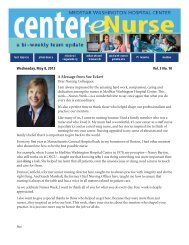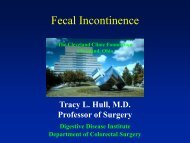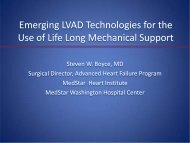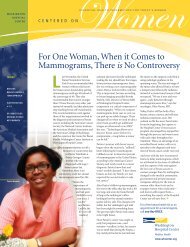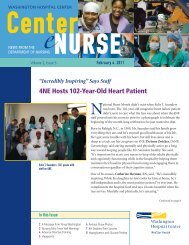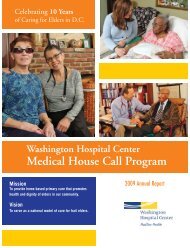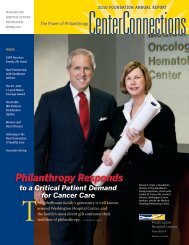Nuclear Medicine - Washington Hospital Center
Nuclear Medicine - Washington Hospital Center
Nuclear Medicine - Washington Hospital Center
You also want an ePaper? Increase the reach of your titles
YUMPU automatically turns print PDFs into web optimized ePapers that Google loves.
<strong>Center</strong><br />
inside<br />
f cus<br />
<strong>Nuclear</strong> <strong>Medicine</strong><br />
Diagnosing Conditions and Treating Cancer<br />
<strong>Nuclear</strong> <strong>Medicine</strong> does exactly what its name implies. The department<br />
— with more than 30 physicians, technologists and support staff<br />
— uses radioactive substances to help diagnose conditions and<br />
treat certain cancers. It might sound scary, but the team takes a friendly<br />
approach to make testing as painless and educational as possible.<br />
“To diagnose conditions, we either inject or have the patient swallow<br />
a radioactive substance called an isotope or tracer,” said technologist<br />
Rob Blosser, CNMT, NCT, section chief. “Then we create an image with a<br />
gamma camera. The images help physicians diagnose certain conditions.”<br />
<strong>Nuclear</strong> medicine also is used as cancer therapy. MedStar<br />
<strong>Washington</strong> <strong>Hospital</strong> <strong>Center</strong> treats more thyroid cancer patients than<br />
any other hospital in the area, and has one of the largest volumes in the<br />
United States, attracting patients from all over the world.<br />
“We focus on three major areas,” said Medical Director Douglas<br />
Van Nostrand, MD (aka Dr. Van). “Endocrinology for thyroid cancer, cardiac<br />
imaging for coronary artery disease, and PET-CT for other cancers.”<br />
Dr. Van said about 30 different studies are used to diagnose or treat<br />
patients. Each study uses an isotope that can be “packaged” to be delivered<br />
by pill or through an IV to a specific organ or body system.<br />
<strong>Nuclear</strong> medicine is similar to X-ray, in that it takes images inside<br />
the body. Unlike X-ray, gamma images are used to examine one or more<br />
functions of organs. For instance, multi-step stress tests are performed to<br />
look for heart perfusion (proper blood flow) through the heart. Patients first<br />
are injected with a special isotope that goes to the heart, and an image<br />
<strong>Center</strong> spread<br />
2012<br />
Super Bowl<br />
spirit day<br />
5Focusing<br />
on People 12<br />
PERSONALLY<br />
M A KIN G A DIFFEREN CE<br />
Lost<br />
the<br />
Weight,<br />
Gained a<br />
Lifetime<br />
continued on page 6<br />
15Know the<br />
Code: Code<br />
Yellow<br />
MarCh/apriL 2012<br />
vOLuMe 3 nuMBer 2<br />
Girma Legesse, CnMt, and<br />
rowena Malaya, CnMt<br />
trevor Forde,<br />
administrative<br />
coordinator<br />
and program<br />
coordinator; tasha<br />
peterson, thyroid<br />
Clinic coordinator;<br />
Claudia Green,<br />
MOaii; tamiko<br />
ashton, Med MOa<br />
ii (seated); Joyce<br />
ervin, nuclear <strong>Medicine</strong><br />
navigator, and robert<br />
Bailey, MOaii
a message from John sullivan<br />
Time for Renewal<br />
Spring came early this year. The weather is already warming<br />
up. The power of renewal is in the air. At the <strong>Hospital</strong><br />
<strong>Center</strong>, it has felt like spring for awhile. Everywhere you<br />
look, people seem reenergized. There’s more to be done, but<br />
we’ve made excellent progress in a relatively short period of<br />
time. In all of this, you are making the critical difference. You<br />
are making our mission your own. And you are personally<br />
making a difference in the lives of our patients and your<br />
colleagues. Thank you!<br />
You may not realize it, but it is a fact that you have<br />
helped create the blueprint for our change! It stems back<br />
to our last associate feedback survey. At the time, you said:<br />
1) We understand how our jobs contribute to the success of<br />
the <strong>Hospital</strong> <strong>Center</strong>, 2) Department teamwork is improving,<br />
2 <strong>Center</strong>FOCus | MArCH/APrIL 2012<br />
and 3) We are held responsible for<br />
our performance. These were the<br />
areas where you felt the most positive<br />
changes had occurred. In addition,<br />
you pinpointed three key areas for<br />
improvement, and we’ve been focused<br />
on these areas for the past year. The<br />
purpose of this letter is to let you know the progress we’ve<br />
made working on your priorities.<br />
1. You Said: Communication<br />
Needs Improvement.<br />
Here’s What We Did: We built an internal structure<br />
aimed at tearing down communication barriers between<br />
our frontline associates and leadership. We launched the<br />
associate newsletter, <strong>Center</strong>Focus, named by our staff,<br />
with an editorial board of our associates. We revamped<br />
our <strong>Center</strong>Daily newsletter, focused on easy-to-follow<br />
information for you. We started a number of nursing<br />
communications, including the weekly Nurse Leader’s<br />
Bulletin, biweekly <strong>Center</strong> e-Nurse and the quarterly<br />
<strong>Center</strong>Nurse newsletter. We developed huddle messages<br />
every other week for our leaders to share hospital and<br />
departmental goals and objectives with you. And we<br />
created a series of posters in the hallway leading to the<br />
cafeteria that tell the stories behind the achievements of<br />
associates like you.<br />
We’ve recommitted to using StarPort, which gives us an<br />
open channel for listening to your ideas. In the “Our Great<br />
Ideas” section, you can see suggestions you and your<br />
coworkers have submitted during my mini-town<br />
hall meetings and the solutions, as well as how<br />
quickly we responded. It’s all there — so you<br />
can follow the progress. I’ve personally<br />
taken your advice to heart, and real<br />
change is occurring! To date, I’ve held<br />
mini-town hall meetings for 97<br />
departments, and some of our senior<br />
vice presidents have begun their own<br />
series of town hall meetings. We are<br />
fully committed to the creation of a<br />
“listening and fixing” environment.<br />
president John sullivan presents Lorelei reyes-Lumpp, rn,<br />
3C, with his first president’s award for personally Making<br />
a difference. Lorelei was honored for her commitment to<br />
her patients, their care and their safety. Lorelei’s unit has<br />
recognized her for achieving 100 percent in patient safety for<br />
14 consecutive months. read about Lorelei and see more photos<br />
from the award presentation at www.facebook.com/whcenter.
2. You Said: Leadership Needs Improvement<br />
(especially during these uncertain<br />
economic times).<br />
Here’s What We Did: Taking cues from your survey<br />
answers, I pulled together a very strong senior leadership<br />
team. In addition to existing team members, Dr. Janis<br />
Orlowski and Cathie Monge, I have added James Hill,<br />
Douglas Zehner and Susan Eckert, RN. Sue has more than<br />
30 years experience in nursing at MedStar <strong>Washington</strong><br />
<strong>Hospital</strong> <strong>Center</strong>. As a group, this team knows what must be<br />
done and how to go about doing it. We are focused on the<br />
following priorities: quality and safety, patient satisfaction,<br />
associate and physician satisfaction, and financial success.<br />
YOU are critical to the success of each of these priorities.<br />
Together, we’re succeeding. In quality and safety, we’ve<br />
met criteria to earn the Medicare Excellence Award two<br />
years in a row. We’ve dramatically reduced central line<br />
infections. Our patient fall numbers are dramatically<br />
down, and we reduced our mortality rate. For patient<br />
satisfaction, we’re meeting patient expectations in the<br />
areas of Communication on Medication and Discharge<br />
Information. We are moving in the right direction but<br />
still need some work in the areas of Clean and Quiet<br />
Environment, Communication with Nurses, Communication<br />
with Physicians and Pain Control. As far as our financial<br />
performance is concerned, we are slightly ahead of our<br />
target. We’ve done this by watching expenses and building<br />
a strong senior leadership team.<br />
3. You Said: Teamwork — Between<br />
Departments — Needs Improvement.<br />
Here’s What We Did: We focused on removing barriers<br />
and improving communication between departments. One<br />
of the best ways to do that — to foster understanding and<br />
form relationships between departments — is to simply<br />
trade jobs for a short period. So in November 2010, we<br />
initiated the <strong>Center</strong> Partners job shadowing program.<br />
Leaders from a number of departments “walk a mile in the<br />
shoes” of our associates in other departments. It is a great<br />
tool to improve understanding of how the work in one<br />
department affects others. The program has led directly to<br />
new working relationships, improved understanding and<br />
more of the collaborative culture we all seek. Our next<br />
<strong>Center</strong> Partners program is scheduled in May.<br />
We also know we work better as a team when we are<br />
satisfied with our own individual place on the team.<br />
So, we’ve made it a priority to improve your workday<br />
experience, too. During the past year, your department<br />
leader has discussed the details of your department-<br />
specific employee survey and worked with you on making<br />
improvements. This resulted in a document called your<br />
“Action Plan.” Every department has been working on the<br />
changes needed to improve its own environment. I believe<br />
this is the best way for us to improve — to have associates<br />
and leaders in every area of the hospital work together to<br />
make this a better place.<br />
To recognize your importance, we’ve hosted a number of<br />
celebration events to honor you. The December holiday<br />
celebration, a service honoring Rev. Martin Luther King,<br />
Jr., and a fan favorite, Super Bowl Friday, all help foster<br />
the sense of community many of us seek. More activities<br />
are planned for Nurses Week and <strong>Hospital</strong> Week. We also<br />
want to celebrate your success. To further honor you, we<br />
expanded our associate recognition program, <strong>Center</strong>Stars.<br />
It now includes associates demonstrating safety, as well<br />
as those exemplifying service. I’ve started meeting our<br />
<strong>Center</strong>Stars for lunch so we can get to know each other<br />
better. In another program, managers nominate associates<br />
for Lunch with the President, a great way to meet even<br />
more of you and hear your suggestions. On April 19, I<br />
presented the first President’s Award for Personally Making<br />
a Difference to acknowledge Lorelei Reyes-Lumpp, RN,<br />
of 3C, who has made a measureable difference to the<br />
organization. I will be giving at least one President’s Award<br />
each month.<br />
We take your survey answers seriously. It matters. It makes<br />
a difference in the organization’s goals as a whole because you<br />
are personally invested. And it’s reflected in the other measures<br />
we monitor. Our accomplishments in clinical quality and<br />
patient safety, in patient satisfaction and even our financial<br />
success all depend on each of you. It’s gratifying to know that<br />
listening to you has led to stronger performance in so many<br />
other areas.<br />
It comes down to a simple formula. We, as leaders, support<br />
and empower you to deliver the very best care. Patients then<br />
go home satisfied. Satisfied patients will come back and even<br />
send us new patients. New patients lead to new opportunities<br />
— and new revenue to invest in our future.<br />
I know the key ingredient in this formula is supporting and<br />
empowering each of you. That’s why I’ve made it my personal<br />
objective to really listen and respond to the questions, concerns<br />
and criticism provided in the associate survey process.<br />
I hope you’ll agree we’ve made a good start. Together —<br />
with strong leadership, better communication and most<br />
importantly, teamwork—we can achieve even more.<br />
By personally making a difference, you each set the cycle<br />
of progress in motion. You make us a stronger, more successful<br />
hospital — a place where you look forward to working every<br />
day. Renewal is in the air. I want to thank each of you for being<br />
part of it!<br />
MArCH/APrIL 2012 | C enterFOCus<br />
3
4<br />
Congratulations,<br />
Congratulations to the newest group of Safety and Service SuperStars for their outstanding work from<br />
October through December 2011.<br />
SeRVICe STaRS<br />
Ghislane Barry, RN, 5D<br />
Colin Brown, RN, Emergency Department<br />
Stephanie Brown, NP, Arrhythmia <strong>Center</strong><br />
Sherill Carlson, RN, 4G<br />
William Clark, Special Police Officer<br />
angella Clarke, 4F<br />
Regine Cineas, Human Resources<br />
Nicholas Ghartey, RN, CCF, 1EIMC<br />
Renee Jackson, Patient and<br />
Guest Services<br />
Bethany Lankford, RN, 4G<br />
They were recognized by patients,<br />
visitors and/or colleagues for their<br />
commitment to the safety and SPIRIT<br />
values of MedStar Health. SuperStars<br />
are selected and recognized quarterly<br />
at leadership meetings. If you know<br />
an associate or physician deserving<br />
of this award, submit a StarGram.<br />
Nomination forms are located<br />
throughout MedStar <strong>Washington</strong><br />
<strong>Hospital</strong> <strong>Center</strong>.<br />
SuperStars!<br />
<strong>Center</strong>FOCus | MArCH/APrIL 2012<br />
Shevaun Lewallen, RN<br />
Emergency Department<br />
Robert Lowery, MD, MedStar Heart<br />
Institute, Cardiac Surgery<br />
emmanuel Mativo, RN, Float Pool<br />
Jocelin Maxwell, RN, CCF, 2E/2EIMC<br />
Wesley Richardson, PCT, 2H<br />
Dionne Ross, RN, 4Ne<br />
George Sample, MD, Critical Care<br />
and Trauma Services<br />
Katherine Spivey, RN, 3E<br />
Lawanda Taylor-Williams,<br />
Food and Nutrition Services<br />
SaFeTY STaRS<br />
Colin Bonham-Lovett, RN, 2C<br />
Kendall Hall, Main OR<br />
Barbara Jackson, RN<br />
Third Floor Operating Room<br />
Cassie Kralovec, RN, 4NE<br />
Maria Martir-Herroro, PharmD<br />
Clinical Pharmacy<br />
Hasan McDonnaugh, PharmD<br />
Clinical Pharmacy<br />
Fatima Rizvi, PharmD, Clinical Pharmacy<br />
safety stars (above)<br />
(L-r) Cassie Kralovec, rn, 4ne;<br />
hasan Mcdonnaugh, pharmd, Clinical<br />
pharmacy; Fatima rizvi, pharmd,<br />
Clinical pharmacy; Kendall hall,<br />
Main Or; Barbara Jackson, rn, third<br />
Floor Operating room; Maria Martirherroro,<br />
pharmd, Clinical pharmacy;<br />
and Colin Bonham-Lovett, rn, 2C<br />
service stars (left)<br />
(L-r) Lawanda taylor-Williams,<br />
Food and nutrition services; renee<br />
Jackson, patient and Guest services;<br />
Wesley richardson, pCt, 2h; shevaun<br />
Lewallen, rn, emergency department;<br />
George sample, Md, Critical Care<br />
and trauma services; regine Cineas,<br />
human resources; angella Clarke, 4F;<br />
Ghislane Barry, rn, 5d; dionne ross,<br />
rn, 4ne; Jocelin Maxwell, rn, CCF,<br />
2e/2eiMC; Katherine spivey, rn, 3e;<br />
and nicholas Ghartey, rn, CCF, 1eiMC
anna Moseley<br />
Phlebotomist<br />
Laboratory<br />
When phlebotomist anna Moseley<br />
takes blood from a patient, she<br />
gives them something in return:<br />
a smile.<br />
Anna works in <strong>Washington</strong> Cancer<br />
Institute. “Most of these patients have their<br />
Gaynell Colbert<br />
Clearance Financial Representative<br />
Central Financial Clearance<br />
Gaynell Colbert has left a trail of<br />
“good works” since coming to<br />
work for MedStar <strong>Washington</strong><br />
<strong>Hospital</strong> <strong>Center</strong> in 1998. She started<br />
in Environmental Services, worked<br />
in Patient and Guest Services, then<br />
blood drawn frequently, and frankly, would<br />
prefer to be anywhere else. If you just listen<br />
to them and laugh with them, it really helps<br />
them. I often play uplifting songs that make<br />
them move to the music. It comforts them,”<br />
she said.<br />
A MedStar <strong>Washington</strong> <strong>Hospital</strong> <strong>Center</strong><br />
employee for 30 years, Anna has worked<br />
every shift: nights, days, weekends, both<br />
part-time and full-time. Almost all have been<br />
connected to the Lab in some way. “I started<br />
as nurse assistant. Then I worked in Medical<br />
Records while going to school to become a<br />
medical technologist,” she said.<br />
While in school, she learned the<br />
techniques of phlebotomy (drawing blood),<br />
and discovered she was good at it and<br />
liked it, so she changed her career path.<br />
Anna has worked in the main Lab, then as a<br />
phlebotomist drawing blood from inpatients<br />
and outpatients. About seven years ago, she<br />
transferred to the Cancer Institute.<br />
Recently, Anna was awarded a SuperStar,<br />
after she helped a group of cancer patients<br />
navigate through a change in hospital<br />
procedure. The change left those patients<br />
Telecommunications and now in Central<br />
Financial Clearance, where she is a<br />
representative in the Endoscopy Suite.<br />
Gaynell’s shift starts at 6:30 a.m.,<br />
but she is here 10 minutes early, because<br />
patients arrive early and line up outside<br />
the Endoscopy Suite. Gaynell opens the<br />
doors to allow patients to come in and sit<br />
down. Gaynell said this position is a perfect<br />
fit for her; she gets to deliver genuine,<br />
compassionate service to patients and<br />
visitors, every day.<br />
Before being employed here, Gaynell<br />
worked as a home health aide, escorting<br />
clients to the <strong>Hospital</strong> <strong>Center</strong> for their<br />
treatments. As an outsider, Gaynell said<br />
she was intrigued by the seamless way the<br />
<strong>Hospital</strong> <strong>Center</strong> was run. Gaynell loved the<br />
way she and her clients were treated, and<br />
decided she wanted to work here, too. She<br />
submitted job applications for three years<br />
before her determination paid off with a job<br />
offer. “It was an extremely happy day for<br />
me,” she recalled.<br />
focusing on<br />
people<br />
without a way to send blood samples every<br />
month to the University of Arkansas, where<br />
they are enrolled in a special program.<br />
One of those grateful patients wrote a<br />
StarGram about how Anna found a way to<br />
help them. The patient wrote, “Ms. Moseley<br />
went beyond the call of duty to help find<br />
the best and most efficient way to get a<br />
new system in place, and to elicit the help<br />
of the personnel in the hospital’s Laboratory.<br />
I’m sure we would not have been able to get<br />
this done so smoothly without Ms. Moseley’s<br />
assistance. She deserves recognition for her<br />
initiative, devotion to customer service<br />
and professionalism.”<br />
Jane andrews, administrative assistant,<br />
Lab, agrees. She said, “Anna personally<br />
walks the patients down here. They are so<br />
grateful. She’s always there for them and<br />
treats them like family.”<br />
If you would like to suggest an associate for Focusing on People,<br />
send your recommendation to hyunjune.lee@medstar.net.<br />
Gaynell is a self-proclaimed<br />
champion at melting anxiety and<br />
building trust. Her dream job is to be<br />
an ambassador for <strong>Hospital</strong> <strong>Center</strong><br />
associates. She would like to visit<br />
departments around the hospital, talk<br />
with associates and coach them in<br />
delivering outstanding customer service.<br />
Dawn McLaughlin, manager, Admissions,<br />
believes Gaynell would do an excellent<br />
job in such a role. Dawn was supportive<br />
and helpful as Gaynell transitioned from<br />
one position to the next.<br />
“Gaynell is one of the best employees<br />
I’ve ever had,” said Dawn. “She is always<br />
calm, caring, helpful and extremely<br />
generous with her time. When a customer<br />
is emotional or aggravated, Gaynell takes<br />
that opportunity to deliver exceptional<br />
customer service. That’s when she shines.”<br />
“I love solving problems,” said<br />
Gaynell. “Everyone benefits when<br />
customers are treated with respect<br />
and kindness.”<br />
MArCH/APrIL 2012 | C enterFOCus<br />
5
<strong>Nuclear</strong> <strong>Medicine</strong><br />
continued from page 1<br />
is taken. Then patients run on a treadmill or are stressed through<br />
medication, followed by a second injection. Forty to 60 minutes later,<br />
a second image is taken. By comparing the images, physicians can<br />
look for decreased perfusion, which represents blockage of one or<br />
more of the heart arteries.<br />
Tests also look for a variety of other conditions, including<br />
gastrointestinal bleeding, cancer and gall bladder blockage. Bone<br />
imaging looks for fractures.<br />
Innovation and Patient Satisfaction<br />
The tight-knit department prides itself on innovation and<br />
patient satisfaction. Wayne Dunkle, director, has conducted patient<br />
satisfaction surveys since 2001. “Recently we found a company that<br />
provides a real time survey using an iPad®. The survey only takes a<br />
minute, and gives us solid information about critical statistics, such<br />
as wait times, registration process, signage and friendliness of staff.”<br />
The team learned through surveys that some procedures frightened<br />
patients. They worked to find a way to ease their anxiety.<br />
Rob explained, “During a parathyroid scan, a set of images is<br />
taken, using a camera that rotates around, but does not touch, the<br />
patient. The procedure can be claustrophobic for some patients,<br />
causing them to become anxious. We created an explanation guide<br />
with pictures for this and other exams, to show the patients exactly<br />
what will happen during procedures. It has lessened their anxiety and<br />
increased their comfort level.”<br />
This is a perfect example of implementing Dr. Van’s philosophy<br />
of “finding solutions to hurdles.” Dr. Van focuses on building<br />
leadership within the department. His office is filled with ducks that<br />
are a reminder that staff should not be sitting in the water quacking,<br />
but looking for ways to improve. He said, “Our technologists have<br />
been involved in leadership programs since 2003. We’re building a<br />
quality team with little turnover, which is highly cohesive. We like to<br />
foster innovation.”<br />
He continued, “Our staff goes the extra mile to maximize the<br />
yield of the diagnostic utility of scans. It’s one of the hallmarks of our<br />
clinic. We do more parathyroid scans than all the other hospitals in<br />
the D.C. area combined. Why? Because our technique delivers more<br />
answers. Our equipment and technical staff provide better<br />
quality images, which lead to improved interpretations.<br />
The inside joke in our department is that if you can’t<br />
locate the parathyroid adenoma at another hospital,<br />
send your patients to us, and we’ll find it.”<br />
6 <strong>Center</strong>FOCus | MArCH/APrIL 2012<br />
Kanchan Kulkarni, Md, director,<br />
nuclear endocrinology, and<br />
douglas van nostrand, Md,<br />
FaCp, FaCnM, medical<br />
director, nuclear <strong>Medicine</strong><br />
Front row (L-r) elmo acio, Md, director, nuclear Cardiology,<br />
and Mark schneider, Md, research coordinator. Back row (L-r)<br />
Carlos Garcia, Md, director, pet/Ct imaging; shari Moreau, pa,<br />
associate director; Owen Glister, Md, and Wayne dunkle, director<br />
Front row (L-r) Felicia afolayan, nuclear <strong>Medicine</strong> student;<br />
Meg imig, senior technologist, and taneshia Brown, senior<br />
technologist. Back row (L-r) dine Badri, floor coordinator;<br />
rob Blossser, senior technologist and section chief;<br />
thomas hilson, senior technologist; Jason Willis, senior<br />
technologist, and Bridgette skelton, senior technologist<br />
Jeff O’neil, Bsrt, CnMt, pet; Omar Grant, nuclear medicine<br />
technician assistant; and sabrina Wilber, CnMt, rt (Ct)
Pharmacy “Catch of the Month”<br />
Is Long-Standing Safety Initiative<br />
Once a month, about a dozen<br />
pharmacists gather for the<br />
Pharmacy Catch of the Month<br />
meeting in the department’s basement<br />
conference room. Those attending are<br />
seasoned pharmacists who report a<br />
“catch” they or one of their colleagues<br />
made, or are junior pharmacists getting<br />
valuable education about clinical<br />
pharmacy.<br />
A catch occurs when a pharmacist<br />
finds an inconsistency or something<br />
wrong with a medication order. It<br />
might be the drug is unsuitable for the<br />
patient, the patient should continue<br />
taking previously prescribed medications<br />
while hospitalized, or the patient has a<br />
life-threatening drug allergy that was<br />
overlooked. As a result of some recent<br />
catches, six pharmacists recently were<br />
named Safety Stars.<br />
The Catch of the Month meeting<br />
has elements of “Who wants to be<br />
a Millionaire,” with Jay Barbaccia,<br />
PharmD, director, Department of<br />
Pharmacy, and Jennifer Brandt, PharmD,<br />
clinical specialist, shooting questions at<br />
the pharmacists about the submissions.<br />
While the game-like atmosphere is<br />
light and there’s a lot of laughter, the<br />
pharmacists are discussing serious issues<br />
such as medication reconciliation, cost<br />
savings to the hospital and patient,<br />
and even life-threatening patient<br />
safety concerns.<br />
“Part of a pharmacist’s job,”<br />
explained Dr. Barbaccia, “is to evaluate<br />
the electronic medication orders in the<br />
context of the patient’s age, sex, weight,<br />
race, physiologic function, primary and<br />
secondary disease processes, and drug<br />
therapy the patient is receiving. The<br />
pharmacist uses intrinsic knowledge, as<br />
well as the computer prompts for drug<br />
allergies, drug interactions or duplication.<br />
We get about 22,000 alerts a month. Of<br />
those, about 7,000 require the pharmacist<br />
to contact the prescriber. That’s usually<br />
where we find a catch.”<br />
Pharmacists work in teams to<br />
evaluate and record medication<br />
orders. “That way there is 200 percent<br />
2012 employee Opinion Pulse Check Survey Coming in May<br />
MedStar <strong>Washington</strong> <strong>Hospital</strong> <strong>Center</strong> is working to improve the associate experience, and needs your help<br />
to tell us how we’re doing. Take the 2012 Employee Opinion Pulse Check Survey from May 7 to 20. This<br />
survey will check the “pulse” of our organization, and measure associates’ satisfaction and commitment.<br />
This 26-question survey is organized into four categories, and the results<br />
will describe your opinions about:<br />
1. The quality of the patient care we provide (our core work)<br />
2. The value of teamwork/employee safety<br />
3. Leadership (we understand “the business,” and our work is important)<br />
4. Your overall pride in your work and in MedStar <strong>Washington</strong> <strong>Hospital</strong> <strong>Center</strong><br />
The survey will be conducted electronically. The results will be shared with associates and used<br />
in our continued efforts to improve workplace excellence at MedStar <strong>Washington</strong> <strong>Hospital</strong> <strong>Center</strong>.<br />
safety<br />
corner<br />
standing (L-r) Charlene Chen, pharmd, clinical pharmacist i; dan totleben, pharmd, staff<br />
pharmacist; pauline Guthrie, pharmd, clinical coordinator; Wafaa abou-Zeineddine, pharmd,<br />
clinical specialist pharmacist; Minhee Kang, pharmd, pharmacy practice resident; and Kimlee<br />
smith, pharmd, pharmacy practice resident. seated (L-r) Jennifer Brandt, pharmd, clinical<br />
specialist pharmacist; Lisa peters, pharmd, BCps, clinical pharmacist i; Jay Barbaccia, pharmd,<br />
Fashp, director of pharmacy; and helen haileselassie, pharmd, staff pharmacist<br />
accountability. That’s essential in the<br />
medication process,” said Dr. Barbaccia.<br />
The department has held “Catch of<br />
the Month” meetings for three years.<br />
“We use it as a teaching opportunity,”<br />
said Dr. Brandt. “We’re reinforcing basic<br />
science skills with our newer members<br />
and getting them to apply those in<br />
clinical environments.”<br />
Every month, the various work teams<br />
submit their best catches. Three are<br />
selected as a Catch of the Month; one<br />
is related to safety, one to medication<br />
reconciliation and the third to finance.<br />
Dr. Barbaccia said, “This is the practice<br />
of clinical pharmacy: trying to assure the<br />
best clinical and financial outcomes.”<br />
MArCH/APrIL 2012 | C enterFOCus<br />
7
2012 Super Bowl Spirit Day<br />
A different kind of team SPIRIT took hold at MedStar <strong>Washington</strong><br />
<strong>Hospital</strong> <strong>Center</strong> just before the Super Bowl, as associates traded in<br />
suit jackets and scrubs for their favorite NFL team jerseys.<br />
angela thompson, 5F<br />
diane harris, rn; Kim sinkford, rn and<br />
aimee Zeprick, rn, 4C<br />
8<br />
<strong>Center</strong>FOCus | MArCH/APrIL 2012<br />
alton Mcadoo,<br />
Food & nutrition<br />
services<br />
torina Carter and<br />
Michelle Long,<br />
admissions<br />
ann radley, rn,<br />
supplemental staffing<br />
denise al-deen,<br />
Family health <strong>Center</strong>
patricia Wiggins and Kim Kelly,<br />
patient and Guest services<br />
angie John, rn,<br />
same day surgery<br />
deondrea taylor,<br />
emergency department<br />
Wanda elane,<br />
Lab - Chemistry<br />
Chris pittman, Food<br />
& nutrition services<br />
taryn hogan, rn, 4d<br />
and Walter Murphy,<br />
engineering<br />
Barbara Zickafoose,<br />
Breast <strong>Center</strong>, and<br />
ti-hesia rudolph,<br />
radiation Oncology<br />
MArCH/APrIL 2012 | <strong>Center</strong>FOCus<br />
9
10<br />
viewpoints<br />
How are you Personally Making a Difference<br />
at MedStar <strong>Washington</strong> <strong>Hospital</strong> <strong>Center</strong>?<br />
Victor Jones<br />
Phlebotomist<br />
Outpatient Lab<br />
“I personally make a<br />
difference with my great<br />
personality, by giving a<br />
smile to all my patients and<br />
coworkers.”<br />
Kim Loften<br />
Patient & Guest Services<br />
Representative<br />
Patient & Guest Services<br />
“I give directions to our<br />
patients and visitors<br />
and escort them to their<br />
destinations, when needed. I<br />
also make sure patients who<br />
need wheelchairs get them.”<br />
Vickie Jews<br />
Patient Care Technician<br />
4NW<br />
“I always try to do my best.<br />
I’m friendly, courteous and<br />
help others whenever I can.”<br />
Debra arrington<br />
MOA III<br />
Breast Imaging <strong>Center</strong><br />
“I serve patients with a smile,<br />
and ask in a nice gentle<br />
manner, ‘How may I help<br />
you?’”<br />
alicia Turner<br />
MOA II<br />
Third Floor OR<br />
“I make sure patients are<br />
safe, in a clean environment,<br />
and happy when they leave<br />
the facility.”<br />
<strong>Center</strong>FOCus | MArCH/APrIL 2012<br />
emily Miller<br />
Environmental Services Aide<br />
Environmental Services<br />
“I clean the hospital every<br />
day, and make it presentable<br />
to visitors, patients and their<br />
families.”<br />
Darlene Ruth<br />
Admitting Representative<br />
Admitting – Bed<br />
Management<br />
“I put patients first, whether<br />
I’m on the clock or not. When<br />
I’m here, I’m here to serve. I<br />
enjoy what I do, which makes<br />
it easy to help others.”<br />
amber Pack, RN<br />
Electrophysiology Lab<br />
“I treat everyone as a VIP.”<br />
Daa’iyah Cooke<br />
Administrative Coordinator<br />
Women’s and Infants’<br />
Services<br />
“I help people when I see<br />
they need it, and I always<br />
give the best service I can.”<br />
Vincent Winters<br />
Maintenance Mechanic<br />
Engineering<br />
“I’m a team player and I<br />
assist patients, as needed.”<br />
ahmad Malik, MD<br />
Internal <strong>Medicine</strong><br />
“I take the time to talk to<br />
patients and their families, and<br />
answer their questions.”<br />
Gina Price<br />
MOA II<br />
Orthopaedic Surgery<br />
“I do the best job I can to<br />
put patients first. I provide<br />
assistance when I see someone<br />
who needs directions or help.”<br />
Julie Douglas, RN<br />
Heart Failure Transplant<br />
MedStar Heart Institute<br />
“I try whenever I can to help<br />
patients with directions and<br />
find their destinations, so<br />
they can make it to their<br />
appointments on time.”<br />
Michael Gold, MD<br />
Gastroenterology<br />
“I make a difference through<br />
expertise and compassion. You<br />
have to be good at what you<br />
do, but you also have to be<br />
caring. I try to instill that in my<br />
team.”<br />
Keisha Weldon<br />
MOA II<br />
Women’s Oncology <strong>Center</strong><br />
“I make sure patients have<br />
everything they need, and I try<br />
to go above and beyond my<br />
duties all the time.”
Wrapping Cancer Patients<br />
in Prayer and Warmth<br />
It’s a beautiful sight to see — women<br />
from all walks of life coming together<br />
for a great cause, wrapping cancer<br />
patients in prayer and warmth.<br />
Since 2009, <strong>Washington</strong> Cancer<br />
Institute’s Prayer Shawl Ministry program<br />
has brought these caring people together<br />
to donate their time, talent and energy,<br />
as they sit and knit or crochet prayer<br />
shawls for strangers who are struggling<br />
with cancer. Their hope is the shawls will<br />
embrace, inspire, comfort, cover,<br />
console and celebrate the lives of<br />
cancer patients. The Prayer<br />
Shawl Ministry is a non-faith<br />
based program, established to<br />
create handmade shawls for<br />
patients undergoing<br />
treatment at <strong>Washington</strong><br />
Cancer Institute.<br />
The shawls get their names<br />
because prayers are said throughout the<br />
creation process. The person who knits<br />
the shawl can say prayers or positive<br />
affirmations for the individual who will<br />
receive it. Upon completion, these shawls<br />
are blessed at the monthly sessions<br />
before becoming available to recipients.<br />
Patients can select the item they are<br />
drawn to, whether by color, fabric<br />
or shape.<br />
The Shawl Ministry meets in<br />
Siegel Auditorium on the fourth<br />
Monday of each month. As many<br />
as 20 associates regularly<br />
attend the sessions. The group<br />
spends each session hour<br />
crafting shawls, networking<br />
and sharing skills.<br />
Central Patient Transport<br />
(CPT) is sporting a new look.<br />
hazel evans, mail room clerk, displays a<br />
shawl she crocheted for cancer patients.<br />
“It’s a wonderful group of spirited<br />
ladies,” said Lorna DeLancy, community<br />
outreach coordinator, Cancer Support<br />
Services. “They spend their time, and<br />
donate yarn, needles and hooks<br />
that group members use to<br />
keep the program thriving.”<br />
(L-R) Milira Allen, Arlette Robinson,<br />
Bobby Poston, Derrick Allen and Recardo<br />
Futrell model their new uniforms. The<br />
MedStar Yellow top and MedStar Blue<br />
pants replace the all-brown ensemble<br />
CPT members used to wear. With the<br />
new uniforms, CPT became the first<br />
department at MedStar <strong>Washington</strong><br />
<strong>Hospital</strong> <strong>Center</strong> to wear uniforms with<br />
our hospital’s new name and logo.<br />
Karen richardson, rn,<br />
Women’s Wellness <strong>Center</strong>,<br />
listens as Linda Jackson,<br />
coding and credentialing<br />
specialist, department<br />
of <strong>Medicine</strong>, admires<br />
Karen’s handiwork.<br />
MArCH/APrIL 2012 | C enterFOCus<br />
11
12<br />
spotlight<br />
Lost the Weight, Gained a Lifetime<br />
Leatitia Holloway, cardiovascular<br />
technologist, Cardiac Catheterization<br />
Lab, didn’t know how serious an<br />
issue her weight was until she wound up<br />
in the Emergency Department. A member<br />
of the Code Blue team, Leatitia was<br />
responding to a call when she had<br />
a severe asthma attack. She weighed<br />
289 pounds.<br />
Leatitia had considered bariatric<br />
(weight loss) surgery for several years,<br />
but this hospitalization was the final<br />
push. Leatitia had gastric bypass<br />
surgery in 2001. In eight months, she<br />
lost 174 pounds.<br />
“It’s like a new person was unzipped<br />
and stepped out,” she said.<br />
For years, Leatitia suffered from<br />
ankle swelling, joint pain, asthma and<br />
breathlessness. However, she didn’t<br />
attribute these conditions to her<br />
weight. “You don’t realize you have all<br />
these issues until you don’t have them<br />
anymore,” she shared.<br />
Leatitia is no longer a bystander in<br />
her children’s activities. Since the surgery,<br />
before<br />
after<br />
she now plays and interacts with her kids<br />
— something she wasn’t able to do before<br />
without huffing and puffing.<br />
The Benefits of<br />
Bariatric Surgery<br />
Seventy-two million people in the<br />
United States are obese, according to the<br />
<strong>Center</strong>s for Disease Control. Like Leatitia,<br />
they may not realize other conditions<br />
caused by being significantly overweight,<br />
such as sleep apnea (abnormal breathing<br />
during sleep), breathlessness, achy joints,<br />
type 2 diabetes and constantly feeling<br />
unwell. Bariatric surgery can correct<br />
these issues for many patients.<br />
Patients who have had the<br />
procedure have reported overall health<br />
improvement, waking up refreshed<br />
because they are no longer troubled by<br />
sleep apnea, breathing easier and having<br />
more endurance. Many also have gone<br />
off medications for conditions caused<br />
by or made worse by obesity. Bariatric<br />
surgery may also cure type 2 diabetes.<br />
National data shows type 2 diabetes is<br />
before<br />
reversed in 83 percent of patients who<br />
undergo gastric bypass, and in 62 percent<br />
of patients who have had adjustable<br />
gastric banding.<br />
Melani Goodman, RN, nurse<br />
navigator, Melanoma and Skin Oncology<br />
<strong>Center</strong>, <strong>Washington</strong> Cancer Institute, had<br />
bariatric surgery because she didn’t want<br />
to develop diabetes, heart disease or high<br />
blood pressure, which ran in her family.<br />
She also felt a sense of obligation to her<br />
patients. At her heaviest, Melani weighed<br />
290 pounds.<br />
“I can’t teach them one thing and<br />
do something different myself. I had to<br />
tackle my weight,” she said.<br />
Multiple pregnancies during 13 years<br />
left their toll on Melani’s body. She tried<br />
diets and exercise to bring her weight<br />
down to a pre-pregnancy weight of 180<br />
pounds. Unable to get lasting results,<br />
she turned to Frederick Finelli, MD, JD,<br />
medical director, Operating Rooms, to<br />
perform bariatric surgery. Her familiarity<br />
with Dr. Finelli and <strong>Hospital</strong> <strong>Center</strong> staff<br />
gave Melani the confidence to make<br />
her decision.<br />
after<br />
Leatitia Holloway Melani Goodman, RN<br />
<strong>Center</strong>FOCus | MArCH/APrIL 2012
She had gastric bypass surgery in 2009,<br />
weighing 271 pounds. Four months later, she<br />
lost 74 pounds. She’s lost even more weight<br />
since the surgery, and is close to her goal<br />
weight. Melani watches what she eats and<br />
exercises three to four times a week. And<br />
of Dr. Finelli, she says, “He’s my hero.”<br />
Bariatric surgery is not a quick fix, and<br />
it requires a great deal of commitment,<br />
with many lifestyle adjustments, such as<br />
regular exercise and eating right. However,<br />
as Timothy Shope, MD, FACS, FASMBS,<br />
director, Program for Advanced Laparoscopic<br />
and Bariatric Surgery pointed out, “We’re<br />
making people healthier and giving them<br />
a better quality of life — easier breathing,<br />
sleeping and walking.”<br />
What Is<br />
Bariatric Surgery?<br />
MedStar <strong>Washington</strong> <strong>Hospital</strong> <strong>Center</strong><br />
offers four bariatric, or surgical<br />
weight loss, procedures. Each involves<br />
making the stomach smaller, therefore limiting<br />
the amount of food one can eat.<br />
Gastric bypass – the stomach is divided<br />
into a small upper pouch, and the small<br />
intestine is rerouted to bypass the rest of<br />
the stomach<br />
Adjustable gastric banding – a band-like<br />
device is place around the top portion of<br />
the stomach to create a small pouch<br />
Sleeve gastrectomy – approximately 75<br />
percent of the stomach is removed<br />
Revisional surgery – addresses “failure” or<br />
complications of a previous procedure<br />
MedStar <strong>Washington</strong> <strong>Hospital</strong> <strong>Center</strong> is<br />
the MedStar South leader for bariatric surgery.<br />
MedStar Franklin Square Medical <strong>Center</strong> and<br />
MedStar Montgomery Medical <strong>Center</strong> also<br />
offer bariatric surgery services.<br />
Front row (L-r) John Brebbia, Md; Frederick Finelli, Md; timothy<br />
shope, Md; and timothy Koch, Md. Back row (L-r) Catina Wood,<br />
surgical coordinator; nicole Brooks, medical office assistant;<br />
Kenneth alexander, rn, bariatric nurse coordinator; anyea Lovette,<br />
rd, dietitian; and Barbara vaughn, administrative manager.<br />
Meet the Bariatric Surgery Team<br />
Timothy Shope, MD, leads the bariatric surgery team.<br />
Extensively trained, and with broad expertise, the team<br />
includes bariatric surgeons, a gastroenterologist, nutritionist<br />
and bariatric nurse coordinator. Ours is the only program in the<br />
<strong>Washington</strong>, D.C., metropolitan area with a gastroenterologist<br />
specializing in the long-term management of bariatric patients.<br />
This expertise is important for monitoring patients for vitamin and<br />
nutritional deficiencies that can arise after surgery.<br />
MedStar <strong>Washington</strong> <strong>Hospital</strong><br />
<strong>Center</strong>’s health insurance<br />
provider, CareFirst BlueCross<br />
BlueShield, now covers the<br />
treatment costs for morbid<br />
obesity, including bariatric surgery.<br />
associates who want to learn if bariatric surgery is<br />
right for them can call 202-877-7257 to register<br />
for a free information session. More information is<br />
available at www.medstarwashington.org/bariatrics.<br />
MArCH/APrIL 2012 | C enterFOCus<br />
13
14<br />
Celebrating Dr. King’s Legacy<br />
MedStar <strong>Washington</strong> <strong>Hospital</strong> <strong>Center</strong> honored the life and legacy<br />
of Dr. Martin Luther King Jr. at our annual celebration. ABC 7<br />
News Anchor Leon Harris delivered the keynote address and<br />
spoke about Dr. King’s impact on his career. He also called the <strong>Hospital</strong><br />
<strong>Center</strong> the embodiment of Dr. King’s vision, noting our associates with<br />
multiracial and multicultural backgrounds who work together at all<br />
levels to serve a diverse patient population. Mosaic Harmony entertained<br />
the crowd with a musical performance.<br />
above: Mosaic harmony performs<br />
Below: aBC 7 news<br />
anchor Leon harris<br />
meets Kim Queen,<br />
learning coordinator,<br />
<strong>Center</strong> for innovative<br />
Learning. Leon spent<br />
time before and<br />
after the celebration<br />
to meet associates<br />
who are fans of his<br />
newscasts.<br />
Left: Leon harris and<br />
Medstar <strong>Washington</strong><br />
hospital <strong>Center</strong> president<br />
John sullivan<br />
Want to see more photos<br />
from the Martin Luther King<br />
Jr. Celebration? Visit the MedStar<br />
<strong>Washington</strong> <strong>Hospital</strong> <strong>Center</strong> Facebook page to<br />
view our photo album from the event. While you’re<br />
there, be sure to “like” us. You won’t want to<br />
miss your own photo or the latest updates, as we<br />
celebrate our <strong>Hospital</strong> <strong>Center</strong> associates.<br />
<strong>Center</strong>FOCus | MArCH/APrIL 2012<br />
Heart Health<br />
Commemorative Stamp<br />
MedStar <strong>Washington</strong> <strong>Hospital</strong> <strong>Center</strong> hosted the<br />
unveiling of the United States Postal Service’s<br />
Heart Health commemorative stamp. The U.S.<br />
Postal Service hopes to raise public awareness about<br />
the importance of maintaining a healthy heart through<br />
the Heart Health stamp, which shows a figure running,<br />
a yellow sun, a leafy green tree icon, a blue swirl<br />
of a sky, an apple and a heart. Stuart Seides, MD,<br />
physician executive director, MedStar Heart Institute,<br />
gave the welcoming speech.<br />
(L-r) stuart seides, Md, physician executive director, Medstar<br />
heart institute; Barry Franklin, phd, member, american<br />
heart association Board of directors; regina Benjamin, Md,<br />
u.s. surgeon general; patrick donahoe, postmaster general<br />
and chief executive officer, u.s. postal service; and Michael<br />
torchia, fitness leader and founder of Operation Fitness.<br />
NBC4 Health and Fitness expo<br />
MedStar <strong>Washington</strong> <strong>Hospital</strong> <strong>Center</strong> partnered<br />
with NBC4 at its annual Health and Fitness<br />
Expo. Visitors received free health screenings,<br />
medical and health information, and participated in a<br />
variety of interactive sports and fitness activities.<br />
More than 150 <strong>Hospital</strong> <strong>Center</strong> associates<br />
volunteered their time during this two-day event,<br />
and provided:<br />
515 glaucoma screenings<br />
830 melanoma screenings<br />
1,235 blood pressure/glucose<br />
Thank you for your generous commitment<br />
to a great program.<br />
Medstar <strong>Washington</strong> hospital <strong>Center</strong><br />
volunteers give visitors vision tests.
What Is a Unit Clerk?<br />
The unit clerk position in hospitals<br />
was created during World War II to allow<br />
nurses more time at the bedside. Since<br />
then, the unit clerk position has evolved<br />
from assisting nurses to being a key<br />
member of a patient care unit.<br />
In her role as a unit clerk on<br />
4C, Leola Stokes provides clerical<br />
assistance, including data entry, medical<br />
transcription, ordering medical and office<br />
supplies, answering phones and bed call<br />
bells, relaying messages to patients and<br />
medical staff, directing visitors to patient<br />
rooms, and distributing mail, newspapers<br />
and flowers.<br />
Leola has been a unit clerk for<br />
the past three years on 4C. “My job is<br />
extremely busy, but rewarding. I know<br />
I make a difference in the lives of the<br />
Know the Code –<br />
Code Yellow<br />
With the region’s busiest Level I trauma center,<br />
MedSTAR Trauma, it’s no wonder Code Yellow is<br />
the most frequently announced emergency code<br />
at MedStar <strong>Washington</strong> <strong>Hospital</strong> <strong>Center</strong>. In 2010, more<br />
than 2,600 trauma codes were called. That’s an average of<br />
219 a month.<br />
There are four types of trauma codes: Trauma<br />
Response, Burn Response, Code Yellow and Code Yellow<br />
Burn. Trauma and burn response are called for the arrival<br />
and examination of patients with injuries from major motor<br />
vehicle accidents, falls from heights greater than 20 feet<br />
and bicycle accidents in which a person loses consciousness.<br />
Code Yellow and Code Yellow Burn indicate more<br />
severe injuries, including gunshot and stab wounds, burns<br />
that affect the airway, and injuries that cause low blood<br />
pressure, high heart rate and uncontrolled bleeding. A<br />
compromised airway and altered mental status are also<br />
reasons for Code Yellows.<br />
Code Yellow and its variants are called when a patient<br />
arrives by ambulance or helicopter to MedSTAR Trauma,<br />
where a coordinated, multidisciplinary team immediately<br />
treats the patient. Team members include a Trauma<br />
attending surgeon, code captain (Trauma team leader,<br />
fourth year surgical resident or Emergency Department<br />
resident), ED attending, surgical interns and medical<br />
students, three MedSTAR nurses, two respiratory therapists,<br />
X-ray technician, trauma prevention and outreach<br />
coordinator, admissions representative, Decedent Affairs<br />
associate, Special Police officer and a chaplain.<br />
patients and visitors as well as the<br />
medical team. I am here to help,” she<br />
said. “When I’m at work, I give it my<br />
best to ensure orders are taken<br />
promptly. I answer the phone politely<br />
and communicate patient needs to the<br />
nurses and patient care technicians in a<br />
timely manner.”<br />
Kim Sinkford, RN, nursing director,<br />
4C, said unit clerks play a vital role in<br />
making a good first impression. “When<br />
unit clerks are friendly and smiling,<br />
it eases the overall environment of a<br />
nursing unit,” she said. “Despite the<br />
volume of admissions and discharges and<br />
demands of the job, the unit clerks on 4C<br />
have a sense of pride and unit ownership.<br />
It takes a special person to perform the<br />
duties of the unit clerk. The ability to<br />
multitask and produce quality work with<br />
Leola stokes, unit clerk, 4C<br />
a smile is at the core of our SPIRIT values.<br />
Unit clerks are the glue that keeps patient<br />
care units together.”<br />
Code yellow team members stand<br />
ready ahead of the patient’s arrival.<br />
the multidisciplinary team at work.<br />
MArCH/APrIL 2012 | C enterFOCus<br />
15
postscript<br />
Capital Bikeshare Is Here<br />
Biking to work just got a little healthier — Capital Bikeshare is<br />
now at MedStar <strong>Washington</strong> <strong>Hospital</strong> <strong>Center</strong>. A Bikeshare rack<br />
has been installed on campus, outside the East Building across<br />
from the Yellow Parking Garage. More than 140 Bikeshare stations are<br />
located across <strong>Washington</strong>, D.C., and Arlington, Va. It’s easy to use:<br />
Choose a bike from any of these stations and return it to any station<br />
near your destination. Bikes can be rented by the day or up to a year<br />
through annual memberships. Go to www.capitalbikeshare.com<br />
for details. Bikeshare riders and Smartphone users can download the<br />
“Spot Cycle” app to check availability of bikes at specific locations.<br />
Remember to follow rules of the road and wear your helmet.<br />
16<br />
<strong>Center</strong>FOCus is produced by the<br />
Public Affairs & Marketing department for the<br />
associates of MedStar <strong>Washington</strong> <strong>Hospital</strong> <strong>Center</strong>.<br />
Please send suggestions, story ideas and comments to<br />
WHC-internal.communications @medstar.net.<br />
MedStar <strong>Washington</strong> <strong>Hospital</strong> <strong>Center</strong> is dedicated to<br />
delivering exceptional patient first health care. We provide the<br />
region with the highest quality and latest medical advances<br />
through excellence in patient care, education and research.<br />
MedStar <strong>Washington</strong> <strong>Hospital</strong> <strong>Center</strong>, a private,<br />
not-for-profit hospital, does not discriminate on grounds<br />
of race, religion, color, gender, physical handicap, national<br />
origin or sexual preference.<br />
John Sullivan<br />
President, MedStar <strong>Washington</strong> <strong>Hospital</strong> Cener<br />
dennis R. wraase<br />
Chairman of the Board, MedStar <strong>Washington</strong> <strong>Hospital</strong> <strong>Center</strong><br />
Kenneth A. Samet, FACHe<br />
President and CEO, MedStar Health<br />
Ty Kennon<br />
Vice President, Public Affairs & Marketing<br />
Carolyn Hammond<br />
Director, Publication Services<br />
Public Affairs & Marketing<br />
Hyun June lee<br />
Managing Editor<br />
Norma Babington<br />
Vickie dempsey-Hall<br />
Contributing Writers<br />
Jennifer Grimes<br />
Graphic Designer<br />
<strong>Center</strong>Focus editorial Board<br />
Bret Cameron, Human Resources<br />
Jason Chandler, Pharmacy<br />
Nicole Colbert, Public Affairs & Marketing<br />
Bernadette denis, RN, 2NW<br />
Trevor Forde, <strong>Nuclear</strong> <strong>Medicine</strong><br />
Vonda Jones, Women’s and Infants’ Services<br />
April Thomas, Telecommunications<br />
Stephen wilcox, Patient and Guest Services<br />
Vaughn williams, Radiology<br />
MedStar washington <strong>Hospital</strong> <strong>Center</strong><br />
110 Irving St., Nw<br />
washington, dC 20010<br />
Visit us at www.medstarwashington.org<br />
<strong>Center</strong>FOCus | MArCH/APrIL 2012<br />
system<br />
spotlight<br />
MedStar Union Memorial <strong>Hospital</strong><br />
a look at our sister<br />
MedStar Health<br />
hospitals and entities.<br />
In 1854, MedStar Union Memorial <strong>Hospital</strong> was the second hospital to open in Baltimore.<br />
(It was then called Union Protestant Infirmary.) It is the only hospital in Maryland to<br />
receive the Delmarva Foundation Excellence Award for Quality Improvement for five<br />
consecutive years. Union Memorial is known for orthopedics, sports medicine, heart care<br />
and the Curtis National Hand <strong>Center</strong>, which is recognized as the largest, most experienced<br />
hand center in the nation.<br />
Key Statistics<br />
249 beds<br />
2,146 associates; 623<br />
affiliated physicians<br />
14,979 inpatient<br />
admissions; 105,662<br />
outpatient visits<br />
Fun Facts<br />
A weeping cherry tree on the hospital campus<br />
was a gift from gangster Al Capone, who was a<br />
patient there in 1939<br />
iGuy is the hospital’s mascot; he’s part of the<br />
hospital’s customer service program called<br />
iCare Always Begins with Me<br />
The open heart surgery program recently<br />
celebrated its 15,000th patient



